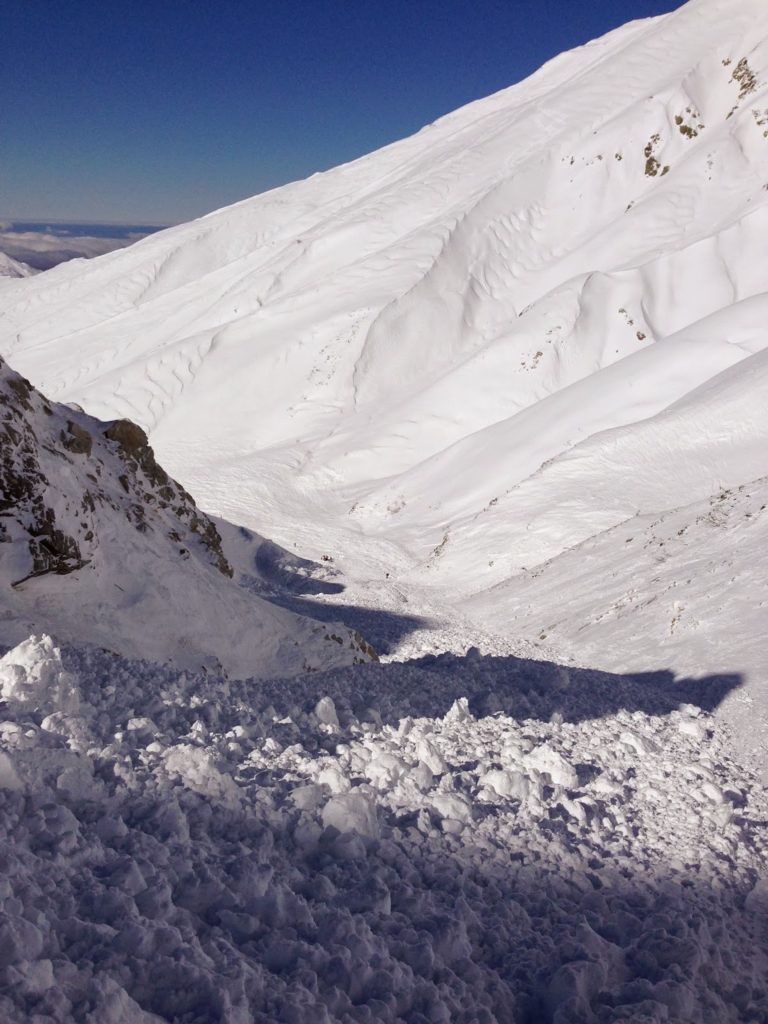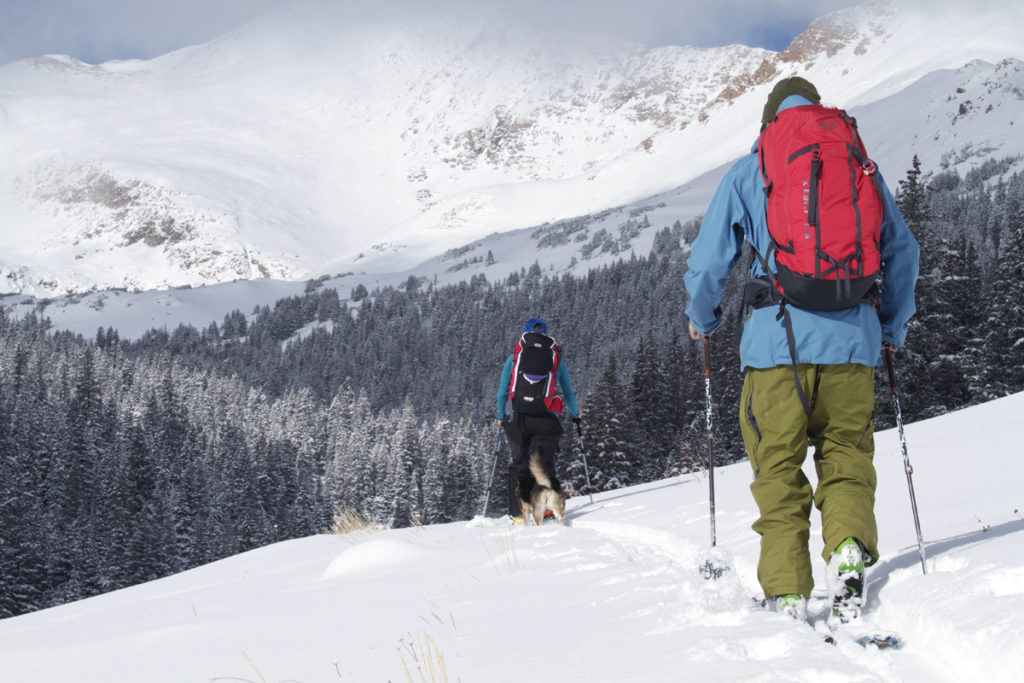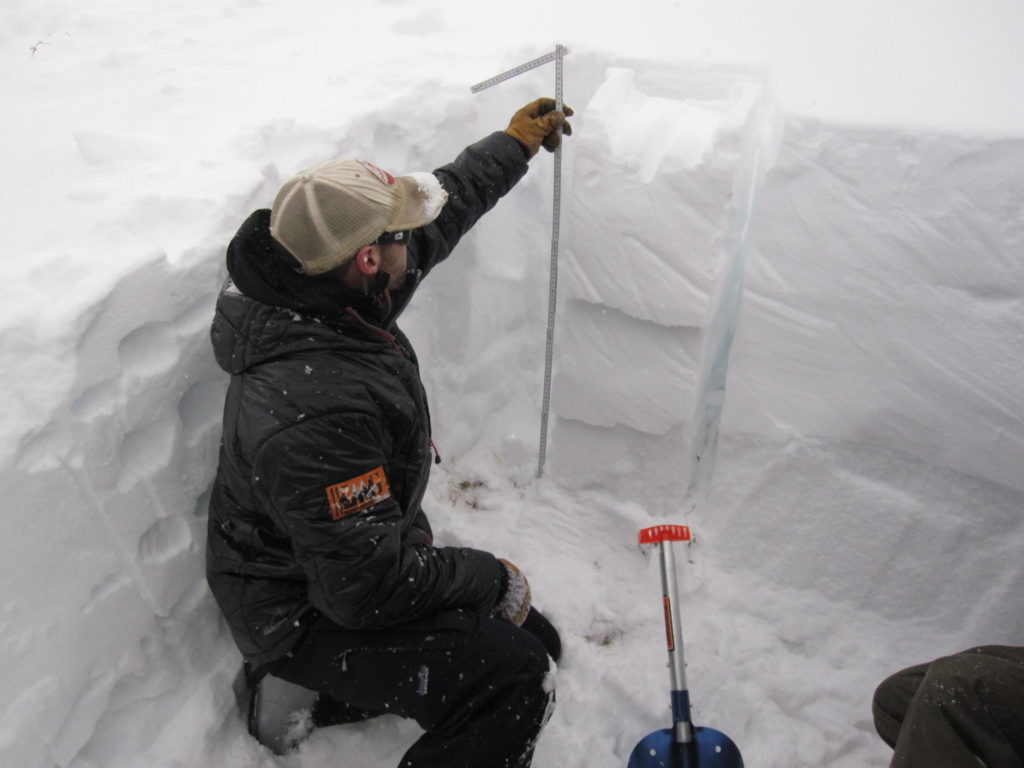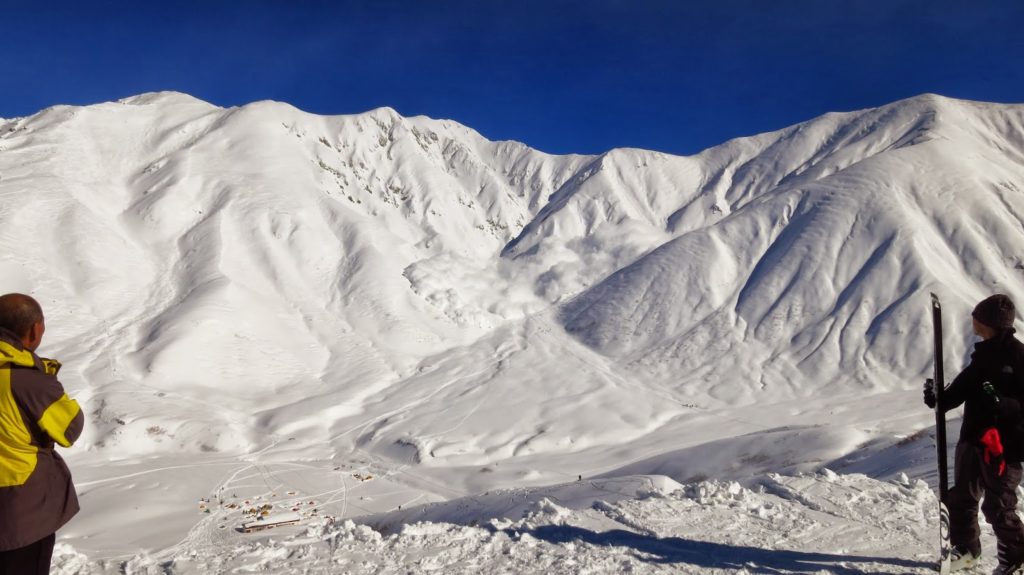It was a typical season-opening day in Tateyama. Hundreds of skiers, boarders and climbers were out to get the first powder of the year. There’s only a tiny window of opportunity up here in November, between the time when there’s enough snow to cover the rocks (hopefully with plenty of soft powder) and when, toward the end of the month, transportation and accommodations in this big alpine bowl simply shut down.

Skier and climber Tracy Lenart was outside Raicho-so on this day, the mountain hut/hotel with a commanding view of the sweeping range of alpine peaks almost completely surrounding it.
“Someone said, ‘Hey, there’s an avalanche,’” Lenart remembers. “I’ve seen quite a few avalanches, but this was the largest.” A huge snow cloud was racing down the folded valleys and ridges of Mt. Masago, just to the southeast of the hut.
After snapping a few photos (videos have also been posted on YouTube), Lenart decided to move. “I thought, what am I doing here taking pictures,” he says.
Skiing down from the hotel, he passed “literally hundreds of people,” he says, but when he got to the actual debris field, no one was checking the debris for victims. “They all just said everything is OK,” Lenart says.
“I didn’t know, and I couldn’t disprove them, but the response kind of stunned me. I’m sure some people were in shock after just being missed by the avalanche, but I felt nobody was doing anything.” So he took out his avalanche transceiver (beacon), switched it to receive and started heading up the concrete-like avalanche debris.
After discounting the signals coming from a group above and to his right, Lenart soon found a signal coming from within the snowpack — and found the first fatality of the accident.
“I was concentrating so hard on what I was doing, because this was the first time I’d ever actually used my beacon in an actual search, that I didn’t realize there were more people working on other victims higher up.”
In all, seven people died in the couloir of Mt. Masago that day. According to the official report by the Japan Avalanche Network (JAN), the country’s leading education and research organization, a husband and wife were skiing high up in the couloir; a group of five below had just finished a break and may also have been skiing together in the snow, which was deep in the area after being blown in by earlier winds — something they should have taken into account.
They weren’t stupid, though, nor were they inexperienced. They just made a very bad decision about where to ski, driven perhaps by the prospect of those first turns of the season in the fresh, deep powder. Or perhaps they were in a group where no one was willing to voice concerns. Too often those are the kinds of decisions that result in avalanche accidents.
The terrain was what avalanche experts would call “complex,” full of ridges and valleys facing different aspects with variable degrees of steepness. “It’s not a place you want to go unless the conditions are exactly right,” says veteran skier and a former director of the Telemark Ski Association of Japan Ryuji Kodama. “You have to know when not to go.”
Whatever the reasons they were there, the deaths from avalanches in Japan nearly reached the total yearly average on that day.
“Looking at statistics over the past 20 years, there are an average of five fatal accidents annually in Japan, with nine fatalities,” says Azusa Degawa, head of JAN. But, he adds, it’s hard to correlate accidents with the increased number of people heading into the backcountry, and that education may in fact be keeping that number from climbing.
“The trends in fatal accidents varies a lot year by year,” he says. “One year we might have just three fatalities; another year it might be mostly climbers rather than skiers. Like elsewhere in the world, accidents tend to happen depending on the avalanche cycles and even if it’s a sunny weekend.
What happened on Mt. Masago was a real tragedy, but there is a lot to the fact that, within one hour, a group of regular backcountry people was able to locate and dig out seven victims buried two meters deep.
They had the equipment, they knew how to use it, and immediately after a very large avalanche, many people moved in and began a very fast search. I think that shows there is a growing awareness of avalanche safety measures in Japan.”
By the Numbers: Avalanche Survival
Here are some sobering facts:
- More than 90 percent of avalanche victims triggered the slide themselves.
- Slightly more than one-quarter of avalanche victims die from trauma; they hit rocks or trees, or get carried over cliffs.
- If you survive the above and are dug out within 15 minutes, you have a 92 percent likelihood of surviving; by 30 minutes it’s down to about 30 percent. Only 28 percent of completely buried victims survive.
- Very few victims survive burial two meters or more below the surface.
Slackers Beware
Bruce Tremper of the U.S. Forest Service and author of Staying Alive in Avalanche Terrain wrote, “The good news is that it’s possible to avoid nearly all avalanches. The bad news is that it requires work.”
It’s not that painful, though; simply reading Tremper’s book (one of the best general introductions to avalanche awareness) is a good start, but one that should be followed with more formal education, and there are more places here in Japan and overseas to start getting some hands-on education.
One new target for that education is not the true backcountry skier or boarder, but those who use the lift to get up the mountain, then take off to the sides of the resort, often referred to as “slackcountry” or “sidecountry.”
“In North America, the avalanche centers have got pretty good coverage, so backcountry people listen to the forecasts, and they know the basics of avalanches,” says Bruce “Edge” Edgerly, Vice President of Backcountry Access (BCA).
The company has been a leader not only in products such as transceivers (it created the first digital beacon in 1997) and airbags, the newest development in avalanche safety, but also a company which puts a great effort in education as a major part of its offering. Edgerly founded the company after he had been buried in an avalanche in his native Colorado.
“The area where there is vulnerability today is in the sidecountry, where people go off the lifts and duck out of bounds,” he says. “They don’t have the barrier of having to know how to use skins and touring gear, so they haven’t done their homework.”
The response from the Snowsports Industry America (SIA) trade group is Project Zero. “This is the first pan-North American effort involving industry and the avalanche centers with a goal of reducing avalanche fatalities to zero,” he says. “It’s idealistic, sure, but that’s an important target. In Japan, sidecountry is where the action is, so this is a real hotspot there as well.
“People need to know it’s no safer just outside the boundaries than it is 20 miles out in the wilderness,” Edgerly says. Unfortunately, where most people heading out into the “real” backcountry today will carry a transceiver, shovel and probe, very few sidecountry skiers do; almost none would have the extra clothing or other emergency gear that would allow them to spend a night out in the snow.
That brings up another important point: avalanches aren’t the only things you can set off to kill yourself. People literally launch themselves out and get lost all the time, and for very bad reasons. Most get rescued, but it’s not as certain as you might think.
As I was writing this story, I received a call. A skier was lost somewhere in or around Suginohara ski area in Myoko Kogen, Niigata. About four years ago, there was a realization locally that the police and fire department — the official rescue organizations — had almost no one familiar with the Myoko backcountry, or capable with touring ski gear (quite different from the Northern Alps and other mountain areas).
So a fledgling search-and-rescue group was set up, of which I was one of the founding members. While the police or fire department finds most lost people close to the ski areas, we’ve had two successful rescues of people really, seriously in trouble.
The call was typical. A young male, skiing alone, heading off the course, no map, lost, a frantic phone call, the phone battery dies. The police field the emergency call, don’t understand everything (the victim was not Japanese), but triangulate the phone to somewhere in the ski area.
Just as the team is getting mobilized for a search starting the next morning — that’s right, after a night out in heavy snow, for safety concerns for the rescuers — the ski area snowcats find the lost rider.
It was a good thing he was found the same day; panicking, he thought following a valley down would be a safe way to get down the hill. Instead, he tumbled into a stream repeatedly; wet and cold, he likely would not have survived the night.
A case on the first day of the year was much more serious. A Japanese snowboarder riding the sidecountry off Ikenotaira ski area saw a nice slope through the trees to the north. There was fresh powder, so it must have been a good ride.
He saw another slope further on, and probably the landmark Akakura Kanko Hotel just across what must have seemed like a small valley. He dropped in what at first was a good line, then tumbled 200 bush-and-tree-covered meters down something close to a sheer cliff.
The fire department and two of us headed out, trying at first to climb a small dam to work up the river toward him (unsuccessfully, as we almost got washed out by continuous sluff avalanches), then worked along a ridgeline above him without hearing any response to our calls.
So he spent one night out in heavy snow. Returning the next morning, we found a spot where we heard his voice, roped in to see if we could find him, then called in the fire department’s climbing specialists.
After hours of searching, hundreds of meters of rope let out and actually coming within just meters of finding him, the day ran out, and everyone left before night fell, leaving him out for another night. (The hard, cold reality is the victim is in an emergency; the rescuers aren’t, so they get off the hill when it gets dark.)
Day three dawned clear, the helicopter flew in, and a miraculously uninjured, un-frostbitten 36-year-old was plucked out of the steep valley.
Good thing, too; the fire department explained the day before to his tearful parents that the official search would only go for three days, and that they would next have to hire private searchers to continue.
Luckily, there was a happy ending — but one that still cost them several hundred thousand yen for the search-and-rescue organization. (Luckily for them, helicopters fly for free, at least in Niigata Prefecture).
The lessons are clear, of course. A ski area’s course map tells you nothing about the terrain beyond it. Going alone without telling anyone exactly where you’re going is a great way to avoid getting help when things go wrong.
Not having the right gear can create a situation that at the least is cold and unpleasant, and at worst will kill you. Not having the right gear and knowledge is basically a selfish act, potentially putting friends and rescuers at risk.
Stuck out there alone, you’ll realize quickly that sidecountry really is backcountry, in the worst possible way.
Backcountry Essentials
- Anyone traveling outside of groomed ski areas should always have the following:
- Avalanche beacon, shovel and probe.
- A topographical map of the area, preferably with compass or GPS.
- Information about recent weather conditions.
- The knowledge to use and apply the above.
- Some extra clothing and gloves.
- A little food and water.
- Friends to slide with, and preferably someone who knows exactly where you’ll be going.
- Cell phone (with battery power) or other means of communication; extra battery.
- The ability to say no when conditions look bad — people are often more difficult to handle than weather, snowpack or terrain.
Avalanche Awareness & Education
■ Japan Avalanche Network (JAN)
JAN is the primary avalanche and snow safety organization in Japan, and is affiliated with and uses materials from the Canadian Avalanche Association (CAA) and Canadian Avalanche Centre (CAC).
JAN provides a range of courses in Japanese for everyone from complete neophytes to guides and avalanche forecasters. “Our goal is a mature avalanche community in Japan,” Azusa Degawa says. “We want to bring up the level of mountain guides and other professionals, and provide educational opportunities for recreational users.”
To accomplish this, JAN holds a serious of free Avalanche Night sessions in the fall (with online streaming), a series of multi-day training sessions drawn from the programs of its partners: CAC for recreational users, and CAA for professionals.
English Instruction Providers
■ Black Diamond Tours (Niseko, Hokkaido) offers regular CAA Certified AST I & AST II from Mid-December through March. They offer some early season class discounts to support locals and seasonal staff as well.
■ Hokkaido Powder Guides (Furano, Hokkaido) offers regular CAA Certified AST I from Mid-December through March.
■ Evergreen Outdoor Center (Hakuba, Nagano) holds a series of CAA Certified AST I and AST II courses through the season, as well as group sessions by request. They also host the ongoing (free) Avalanche Awareness Nights in Hakuba.
■ MountainLife (Hakuba, Nagano) provides regular CAA Certified AST I, AST II and Companion Rescue Skills (CRS) courses.
■ Dancing Snow (Myoko, Niigata) hosts instructors from Canada for CAA Certified AST I courses at fixed times during the season and plans to expand avalanche and snow safety offerings on a more regular basis next season.
Mountain Awareness Socials
Tracy Lenart is one of the organizers of Mountain Awareness Socials (MAS); a series of casual events with presentations, discussions focused on awareness for those interested in riding backcountry and backcountry enthusiasts. The first event was held in Hakuba on Jan. 28 and featured mountain rescue medical technician Menno Boermans.
“Menno has a special skill/gift for conveying “pow” addiction, medical technician experience and knowledge. It was the most informative awareness presentation I’ve experienced,” says Lenard.
The group is not affiliated with any organization. The goal is to simply spread awareness and basic knowledge, and then encourage people to get educated with the organization of their choice. Additional events are planned this autumn.







